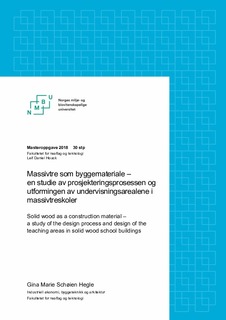| dc.contributor.advisor | Houck, Leif Daniel | |
| dc.contributor.author | Hegle, Gina Marie Schøien | |
| dc.date.accessioned | 2018-09-09T13:52:05Z | |
| dc.date.available | 2018-09-09T13:52:05Z | |
| dc.date.issued | 2018 | |
| dc.identifier.uri | http://hdl.handle.net/11250/2561587 | |
| dc.description.abstract | Fokuset for denne oppgaven har vært å finne ut hvordan det er å prosjektere skolebygg i massivtre og å undersøke hva slags utforming disse skolene har. Massivtre er et materiale i vekst og siden 2010 har volumet av trekonstruksjoner i Norge doblet seg hvert år. Økt bruk av massivtre har en positiv effekt på miljøet, i form av redusert karbonfotavtrykk. I tillegg er det observert at eksponert massivtre er positivt for innemiljø og -klima.
Oppgaven ble avgrenset til å kun se på undervisningsarealene i skolebyggene og har problemstillingen:
Hvordan har bruken av massivtre i skolebygg påvirket prosjekteringen og utformingen av undervisningsarealene i bygget?
Problemstillingen vil bli forsøkt besvart ved hjelp av følgende forskningsspørsmål:
1. Hvilke etasjeskillere blir valgt i massivtreskoler og hvilke følger har valget på utformingen av de generelle læringsarealene?
2. Hvordan har prosjekteringsprosessen vært for skolebygg i massivtre og hvilke fordeler og ulemper ga massivtre?
Det utført en litteraturstudie, en dokumentanalyse og intervjuer. Utvalget som ble analysert bestod av barneskoler, ungdomsskoler, kombinerte skoler og videregående skoler med bæresystem i massivtre. Dokumentstudiet bestod av tekniske tegninger for åtte skoler. Totalt fire arkitekter ble intervjuet om sine erfaringer rundt prosjektering av skolebygg i massivtre.
Oppgaven avdekket at lengre spenn og fleksibilitet er mer utfordrende i massivtrebygg enn i bygg som er konstruert i mer tradisjonelle materialer som stål og betong. Mangelen på standardiserte løsninger for massivtrebygg gjør det vanskelig å oppfylle lyd- og brannkrav. De undersøkte etasjeskillerkonstruksjonene viste ingen klar trend i oppbyggingen, men flertallet var utstyrt med en nedsenket himling bestående av lydisolerende materialer.
For prosjekteringens del var funnene knyttet til at prosjekteringen må være ferdig tidligere enn i andre prosjekter og at det er behov for mer samarbeid på tvers av fagene. Et problem som ble nevnt flere ganger i løpet av arbeidet med denne oppgaven var at sene avgjørelser rundt materialvalget ga store utfordringer for prosjekteringsprosessen. | nb_NO |
| dc.description.abstract | The primary focus of this master thesis was to examine the design process of school buildings in solid wood and to explore the design of these schools. Solid wood is a material in growth and the volume of wooden structures has doubled itself every year since 2010. The increased usage of solid wood has a positive effect on the environment, by reducing the carbon footprint. Observation has shown that exposed solid wood has a positive effect on the indoor environment and the air quality.
The assignment is limited to the teaching areas in the school buildings and aim to answer the following question:
How has the use of solid wood in school buildings affected the design process and the design of the teaching areas in the building?
To achieve this the following research questions was formed:
1. What type of story construction are chosen in solid wood school buildings and what are the effects of this choice on the general teaching areas?
2. How has the design process for school building in solid wood been and what are the benefits and disadvantages of using solid wood?
To answer the previous questions a literature study, a document study and interviews were conducted. The analysed selection consists of primary schools, lower secondary schools, combined primary and lower secondary schools and upper secondary schools with a solid wood bearing system. The document study included technical drawing for eight schools. Four architects were interviewed about their experience with the design process of solid wood school buildings.
The findings reveal that longer spans and flexibility are more challenging in solid wood buildings that in buildings constructed in more traditional materials such as steel and concrete. The lack of standardised methods for solid wood buildings makes it difficult to achieve the requirements for fire and sound. The examined story constructions had some similarities, but none were identical. The most common aspect of the constructions was a dropped ceiling consisting of sound resistant materials.
The results indicated that the design must be finished earlier and that the amount of collaboration is increased in this type of buildings. The late decision of choice of material was highlighted as a factor that made the design phase more difficult. | nb_NO |
| dc.language.iso | nob | nb_NO |
| dc.publisher | Norwegian University of Life Sciences, Ås | nb_NO |
| dc.rights | Attribution-NonCommercial-NoDerivatives 4.0 Internasjonal | * |
| dc.rights.uri | http://creativecommons.org/licenses/by-nc-nd/4.0/deed.no | * |
| dc.subject | Massivtre | nb_NO |
| dc.subject | Skolebygg | nb_NO |
| dc.subject | Undervisningsarealer | nb_NO |
| dc.subject | Etasjeskiller | nb_NO |
| dc.title | Massivtre som byggemateriale : en studie av prosjekteringsprosessen og utformingen av undervisningsarealene i massivtreskoler | nb_NO |
| dc.title.alternative | Solid wood as a construction material : a study of the design process and design of the teaching areas in solid wood school buildings | nb_NO |
| dc.type | Master thesis | nb_NO |
| dc.description.version | submittedVersion | nb_NO |
| dc.subject.nsi | VDP::Teknologi: 500::Bygningsfag: 530 | nb_NO |
| dc.subject.nsi | VDP::Teknologi: 500::Bygningsfag: 530::Arkitektur og bygningsteknologi: 531 | nb_NO |
| dc.subject.nsi | VDP::Teknologi: 500::Materialteknologi: 520::Bygningsmaterialer: 525 | nb_NO |
| dc.source.pagenumber | 90 | nb_NO |
| dc.description.localcode | M-IØ | nb_NO |

